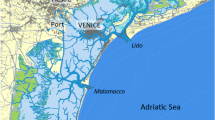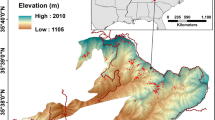Abstract
Risk analysis and assessment relating coastal structures has been one of the hot topics in the area of coastal protection recently. In this paper, from three aspects of joint return period of multiple loads, dike failure rate and dike continuous risk prevention respectively, three new risk analysis methods concerning overtopping of sea dikes are developed. It is worth noting that the factors of storm surge which leads to overtopping are also considered in the three methods. In order to verify and estimate the effectiveness and reliability of the newly developed methods, quantified mutual information is adopted. By means of case testing, it can be found that different prior variables might be selected dividedly, according to the requirement of special engineering application or the dominance of loads. Based on the selection of prior variables, the correlating risk analysis method can be successfully applied to practical engineering.
Similar content being viewed by others
References
Gao, S. S. and Zhang, L. X., 2002. Reliability Theory and Its Application in Engineering, National Defence Industry Press, Beijing. (in Chinese)
Koç, M. L., 2009. Risk assessment of a vertical breakwater using possibility and evidence theories, Ocean Eng., 36(14): 1060–1066.
Kraskov, A., Stögbauer, H. and Grassberger, P., 2004. Estimating mutual information, Phys. Rev. E, 69(6): 066138.
Li, B., 2002. Research on Risk Analysis of Sea Dike Overtopping, Msc. Thesis, Guangxi University. (in Chinese)
Li, C. S., Dai, H. L., Xie, B. H. and Wang, Y. N., 2008. Combination model for ecasting power load based on mutual information, Electric Power, 41(6): 11–13. (in Chinese)
Li, Y. N. and Li, M., 2005. Foundation Course of Information Theory, Beijing University of Posts and Telecommunications Press, Beijing. (in Chinese)
Liu, D. F., Wang, L. P. and Pang, L., 2006. Multi compound extreme value distribution theory and its application in the probability prediction of extreme sea conditions, Science Bulletin, 51(9): 1112–1116. (in Chinese)
Liu, N., Sun, D. Y., Huang, S. C. et al., 2008. The prevention of storm surge disaster and the construction of sea dike engineering, China Water Resources, (5): 9–13. (in Chinese)
Mínguez, R., Castillo, E., Castillo, C. and Losada, M. A., 2006. Optimal cost design with sensitivity analysis using decomposition techniques. Application to composite breakwaters, Struct. Saf., 28(4): 321–340.
van Gent, M. R., 2002. Wave overtopping events at dikes, Proceedings of 28th International Conference on Coastal Engineering, Wales, United Kingdom, 2, 2203–2215.
Voortman, H. G., 2003. Risk-Based Design of Large-Scale Flood Defence Systems, Delft University of Technology, Dutch.
Wang, L. P., Qi, Y. and Dai, W., 2008. Analysis of the probability characteristics of the extreme wave height based on the maximum entropy principle, Theory and Practice of Risk Analysis and Crisis Response (RAC-08), 419–424.
Wang, L. P., Sun, X. G., Lv, K. B. and Xu, D. L., 2012. A maximum-entropy compound distribution model for extreme wave heights of typhoon-affected sea areas, China Ocean Eng., 26(1): 49–58.
Wang, L. P., Zhang, J. F., Li, Y. P. and Zhang, Y. F., 2011. A statistical analysis of typhoon frequency and application in design wave height, Acta Oceanologica Sinica, 30(4): 24–32.
Xiao, Y. F., Duan, Z. D., Xiao, Y. Q., Ou, J. P., Chang, L. and Li, Q. S., 2011. Typhoon wind hazard analysis for southeast China coastal regions, Struct. Saf., 33(4): 286–295.
Yang, X., Liu, Z. L., W, S. S., Li, Z. Q. and Li, C. F., 2012. The risk probability analysis on design combination of wind wave and tidal level in design of sea dike, Journal of Shanghai Jiaotong University, 46(10): 1671–1679. (in Chinese)
Author information
Authors and Affiliations
Corresponding author
Additional information
This research work was supported by Fundamental Research Funds for the Central Universities (Grant No. 201362030), National Natural Science Foundation of China (Grant Nos. 41106077 and 51379195), Zhejiang Provincial Natural Science Foundation (Grant No. R5110036), Shandong Provincial Natural Science Foundation (Grant No. ZR2013EEM034), Open Fund of the Key Laboratory of Research on Marine Hazards Forecasting (Grant No. LOMF1101) and SRF for ROCS, SEM.
Rights and permissions
About this article
Cite this article
Wang, Lp., Huang, Gl., Chen, Zs. et al. Risk analysis and assessment of overtopping concerning sea dikes in the case of storm surge. China Ocean Eng 28, 479–487 (2014). https://doi.org/10.1007/s13344-014-0039-y
Received:
Revised:
Accepted:
Published:
Issue Date:
DOI: https://doi.org/10.1007/s13344-014-0039-y




